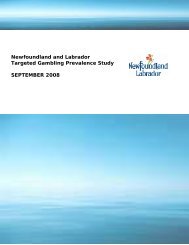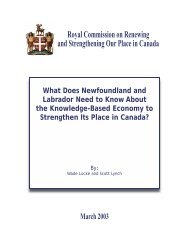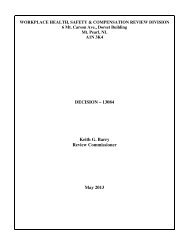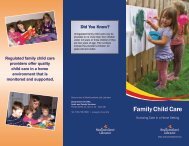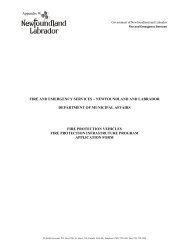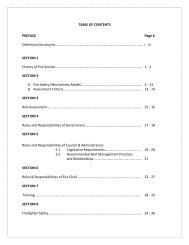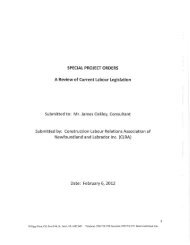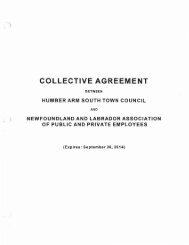Taking Action Against Violence - Government of Newfoundland and ...
Taking Action Against Violence - Government of Newfoundland and ...
Taking Action Against Violence - Government of Newfoundland and ...
Create successful ePaper yourself
Turn your PDF publications into a flip-book with our unique Google optimized e-Paper software.
CURRENT STATUS<br />
<strong>Violence</strong> continues in homes <strong>and</strong> communities in <strong>Newfoundl<strong>and</strong></strong> <strong>and</strong> Labrador. Its<br />
victims include women, children <strong>and</strong> youth, Aboriginal women <strong>and</strong> children, seniors,<br />
persons with disabilities <strong>and</strong> others who are victims <strong>of</strong> violence because <strong>of</strong> race,<br />
ethnicity, sexual orientation, or economic status. According to the most recent<br />
Canadian statistics from the 2004 General Social Survey (GSS) there has not been any<br />
change in the percentage <strong>of</strong> Canadians (7%) 15 years <strong>of</strong> age <strong>and</strong> over in a current,<br />
previous, or common-law union who experienced spousal violence in the previous five<br />
years. (Statistics Canada, 2005). The same survey found that female victims <strong>of</strong> spousal<br />
violence were three times more likely than male victims to fear for their life (34% versus<br />
10%) <strong>and</strong> three times more likely to take time <strong>of</strong>f from their everyday activities because<br />
<strong>of</strong> the violence (29% versus 10%). Individuals between the ages <strong>of</strong> 15 <strong>and</strong> 24 who have<br />
been in a common-law relationship for three years or less, <strong>and</strong> whose partner is a<br />
frequent heavy drinker, are at an increased risk <strong>of</strong> experiencing violence at the h<strong>and</strong>s <strong>of</strong><br />
their intimate partner. These indicators support the need to focus on early intervention<br />
with children <strong>and</strong> young adults.<br />
A 2002 public attitudes survey in <strong>Newfoundl<strong>and</strong></strong> <strong>and</strong> Labrador noted there was a high<br />
concern about children witnessing violence in the family (64%), while 69% were<br />
concerned with school-based violence. 56% <strong>of</strong> respondents indicated that violence<br />
against women <strong>and</strong> violence in dating relationships (53%) were the next biggest<br />
concerns.<br />
During 2004, there were 1,084 admissions <strong>of</strong> women <strong>and</strong> dependent children to<br />
shelters in <strong>Newfoundl<strong>and</strong></strong> <strong>and</strong> Labrador. Of those admitted for abuse, 100% were<br />
fleeing psychological abuse, 67% physical abuse, 60% threats, 33% harassment, 20%<br />
financial abuse, <strong>and</strong> 13% sexual abuse (Statistics Canada). These statistics only<br />
represent a portion <strong>of</strong> actual cases <strong>of</strong> abuse. According to Statistics Canada only a<br />
small percentage <strong>of</strong> victims <strong>of</strong> violence <strong>and</strong> sexual assault contact shelters <strong>and</strong> related<br />
services. The 2004 GSS reported that about one-third (34%) <strong>of</strong> victims (47% female<br />
<strong>and</strong> 20% male) indicated that they had turned to a formal help agency because <strong>of</strong><br />
violence. Also significant is the fact that only 27% <strong>of</strong> victims <strong>of</strong> spousal violence<br />
reported the incidence to the police, which is unchanged from the 1999 GSS.<br />
SETTING THE CONTEXT<br />
Gender Equity<br />
<strong>Violence</strong> is rooted in inequality. The <strong>Government</strong> <strong>of</strong> <strong>Newfoundl<strong>and</strong></strong> <strong>and</strong> Labrador fully<br />
underst<strong>and</strong>s this factor as one <strong>of</strong> the main causes <strong>of</strong> violence against women <strong>and</strong> other<br />
vulnerable populations. Therefore, one <strong>of</strong> the strategies government will employ will be<br />
to use a gender equity lens in the development <strong>of</strong> all policies <strong>and</strong> activities associated<br />
with the plan. The <strong>Government</strong> will also continue to support the work <strong>of</strong> community<br />
based women’s equality-seeking councils <strong>and</strong> others who advance women’s equality.<br />
In this Province, having a Provincial Advisory Council on the Status <strong>of</strong> Women <strong>and</strong> a<br />
Women’s Policy Office are also seen as fundamental mechanisms to ensure that<br />
women share equitably in the social <strong>and</strong> economic benefits <strong>of</strong> our province.<br />
8






